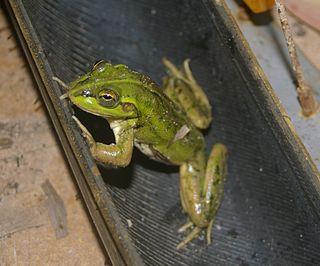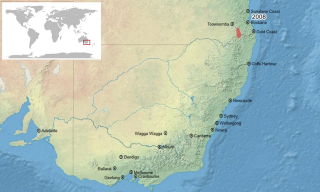
The Hylidae are a wide-ranging family of frogs commonly referred to as "tree frogs and their allies". However, the hylids include a diversity of frog species, many of which do not live in trees, but are terrestrial or semiaquatic.

Ptychohyla is a genus of frogs in the family Hylidae. These frogs are found in the southern Mexican states of Chiapas, Guerrero, and Oaxaca, and Central America to western Panama.
The greater bromeliad tree frog is a species of frog in the family Hylidae endemic to the mountains of central Veracruz and northern Oaxaca, Mexico.
The yellowbelly voiceless tree frog is a species of frog in the family Hylidae endemic to Mexico. Its natural habitats are subtropical or tropical moist lowland forests, subtropical or tropical moist montane forests, and rivers.
It is threatened by habitat loss.

The fairy tree frog is a species of frog in the family Hylidae endemic to Mexico. Its natural habitats are subtropical or tropical moist lowland forests, subtropical or tropical moist montane forests, and rivers. It is threatened by habitat loss.

Corythomantis is a small genus of hylid frogs endemic to northeastern Brazil. It was monotypic until description of a second species, Corythomantis galeata, in 2012. These frogs are sometimes known under common name Greening's frogs.
Isthmohyla xanthosticta is a species of frogs in the family Hylidae. It is endemic to Costa Rica and only known from its type locality on the south slope of Volcan Barba in the Heredia Province. Common name south fork treefrog has been coined for it.

Copland's rock frog or the saxicoline tree frog a frog in the family Hylidae. It is endemic to Australia, in a range extending from the Kimberley region of Western Australia to Arnhem Land and a record in the north of Queensland.
Its natural habitats are subtropical or tropical dry shrubland, subtropical or tropical dry lowland grassland, intermittent rivers, and rocky areas.

Dahl's aquatic frog is a species of frog in the family Hylidae. It is endemic to Australia.

The Wotjulum frog is a species of frog in the family Hylidae. Its habitats are subtropical or tropical dry forests, subtropical or tropical moist lowland forests, subtropical or tropical swamps, rivers, intermittent rivers, swamps, freshwater lakes, freshwater marshes, intermittent freshwater marshes, and rocky areas.
Nyctimystes fluviatilis, also known as the Indonesian big-eyed tree frog, is a species of frog in the family Pelodryadidae, also treated as the subfamily Pelodryadinae in the family Hylidae. It is endemic to New Guinea and is known from Idenburg River and Wapoga River in Papua province, Indonesia, and from the Torricelli Mountains in the East Sepik Province and Kavorabip in the Western Province, both in the western Papua New Guinea.
Nyctimystes kubori is a species of frog in the family Pelodryadidae, also treated as the subfamily Pelodryadinae in the family Hylidae. It is endemic to Papua New Guinea and is widespread in the New Guinea Highlands between 141°E and 147°E and in the mountains of the Huon Peninsula. The specific name kubori refers to its type locality in the Kubor Mountains. Common name sandy big-eyed treefrog has been coined for this species.
Nyctimystes trachydermis, the Morobe big-eyed tree frog, is a species of frog in the family Hylidae, endemic to Papua New Guinea. It occurs in the mountains of southern eastern New Guinea. Its type locality is Gapaia Creek, at 1,280 m (4,200 ft) asl between Garaina and Saureli, in the Morobe Province. The specific name trachydermis means "rough skinned", derived from the Greek words trachys and derma.
Tyler’s big-eyed tree frog is a species of frog in the family Hylidae, endemic to Papua New Guinea. It is only known from its type locality, Gapaia Creek, at 1,280 m (4,200 ft) asl between Garaina and Saureli, in the Morobe Province. The specific name honours Michael J. Tyler, an Australian herpetologist, "in recognition of his notable contributions to the systematics of Australo-papuan frogs."
Ptychohyla acrochorda is a species of frogs in the family Hylidae. It is endemic to Mexico and known from the Atlantic slopes of the Sierra Juárez in Oaxaca. Before being described as a new species in 2000, it was mixed with Ptychohyla erythromma. The specific name acrochorda is a Greek word for "wart" and refers to the distinctive white warts on the posterior surface of the thigh of this frog. Common name warty mountain stream frog has been coined for it.

A tree frog is any species of frog that spends a major portion of its lifespan in trees, known as an arboreal state. Several lineages of frogs among the Neobatrachia have given rise to tree frogs, although they are not closely related to each other.

The cream-backed poison frog is a species of frog in the family Dendrobatidae endemic to Colombia. Its natural habitats are subtropical or tropical, high-altitude grassland, shrub-dominated wetlands, swamps, intermittent freshwater marshes, rural gardens, urban areas, and heavily degraded former forests. The cream-backed poison frog is one of the less-toxic of the family. It has undergone several name changes since its discovery. Originally called Dendrobates subpunctatus, its name was changed to Colostethus subpuctatus once the family Dendrobatidae underwent a division of species and genera other than Dendrobates were coined. Recently, minor skeletal differences have separated the cream-backed poison frog from the rocket frogs, and placed it in another genus entirely, Hyloxalus.
Eastern tree frog may refer to:
The mountain tree frog is a species of frog in the family Hylidae endemic to Mexico.
Yellow-legged frog may refer to:









